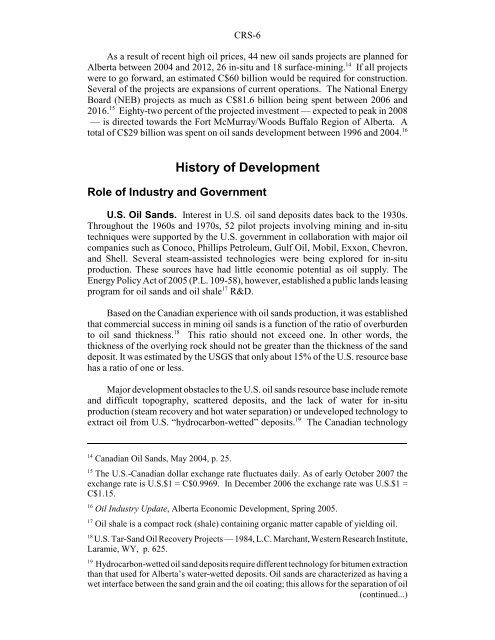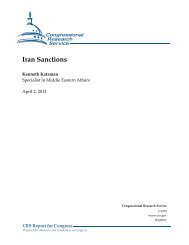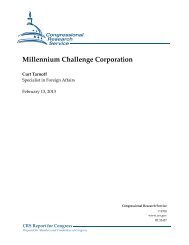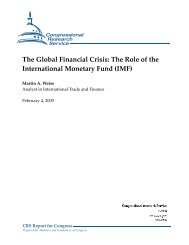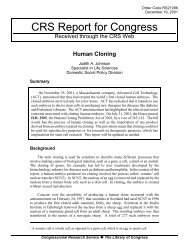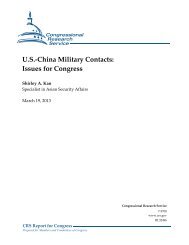North American Oil Sands: History of ... - The Air University
North American Oil Sands: History of ... - The Air University
North American Oil Sands: History of ... - The Air University
You also want an ePaper? Increase the reach of your titles
YUMPU automatically turns print PDFs into web optimized ePapers that Google loves.
14 Canadian <strong>Oil</strong> <strong>Sands</strong>, May 2004, p. 25.<br />
CRS-6<br />
As a result <strong>of</strong> recent high oil prices, 44 new oil sands projects are planned for<br />
Alberta between 2004 and 2012, 26 in-situ and 18 surface-mining. 14 If all projects<br />
were to go forward, an estimated C$60 billion would be required for construction.<br />
Several <strong>of</strong> the projects are expansions <strong>of</strong> current operations. <strong>The</strong> National Energy<br />
Board (NEB) projects as much as C$81.6 billion being spent between 2006 and<br />
2016. 15 Eighty-two percent <strong>of</strong> the projected investment — expected to peak in 2008<br />
— is directed towards the Fort McMurray/Woods Buffalo Region <strong>of</strong> Alberta. A<br />
total <strong>of</strong> C$29 billion was spent on oil sands development between 1996 and 2004. 16<br />
<strong>History</strong> <strong>of</strong> Development<br />
Role <strong>of</strong> Industry and Government<br />
U.S. <strong>Oil</strong> <strong>Sands</strong>. Interest in U.S. oil sand deposits dates back to the 1930s.<br />
Throughout the 1960s and 1970s, 52 pilot projects involving mining and in-situ<br />
techniques were supported by the U.S. government in collaboration with major oil<br />
companies such as Conoco, Phillips Petroleum, Gulf <strong>Oil</strong>, Mobil, Exxon, Chevron,<br />
and Shell. Several steam-assisted technologies were being explored for in-situ<br />
production. <strong>The</strong>se sources have had little economic potential as oil supply. <strong>The</strong><br />
Energy Policy Act <strong>of</strong> 2005 (P.L. 109-58), however, established a public lands leasing<br />
program for oil sands and oil shale 17 R&D.<br />
Based on the Canadian experience with oil sands production, it was established<br />
that commercial success in mining oil sands is a function <strong>of</strong> the ratio <strong>of</strong> overburden<br />
to oil sand thickness. 18 This ratio should not exceed one. In other words, the<br />
thickness <strong>of</strong> the overlying rock should not be greater than the thickness <strong>of</strong> the sand<br />
deposit. It was estimated by the USGS that only about 15% <strong>of</strong> the U.S. resource base<br />
has a ratio <strong>of</strong> one or less.<br />
Major development obstacles to the U.S. oil sands resource base include remote<br />
and difficult topography, scattered deposits, and the lack <strong>of</strong> water for in-situ<br />
production (steam recovery and hot water separation) or undeveloped technology to<br />
extract oil from U.S. “hydrocarbon-wetted” deposits. 19 <strong>The</strong> Canadian technology<br />
15 <strong>The</strong> U.S.-Canadian dollar exchange rate fluctuates daily. As <strong>of</strong> early October 2007 the<br />
exchange rate is U.S.$1 = C$0.9969. In December 2006 the exchange rate was U.S.$1 =<br />
C$1.15.<br />
16 <strong>Oil</strong> Industry Update, Alberta Economic Development, Spring 2005.<br />
17 <strong>Oil</strong> shale is a compact rock (shale) containing organic matter capable <strong>of</strong> yielding oil.<br />
18 U.S. Tar-Sand <strong>Oil</strong> Recovery Projects — 1984, L.C. Marchant, Western Research Institute,<br />
Laramie, WY, p. 625.<br />
19 Hydrocarbon-wetted oil sand deposits require different technology for bitumen extraction<br />
than that used for Alberta’s water-wetted deposits. <strong>Oil</strong> sands are characterized as having a<br />
wet interface between the sand grain and the oil coating; this allows for the separation <strong>of</strong> oil<br />
(continued...)


